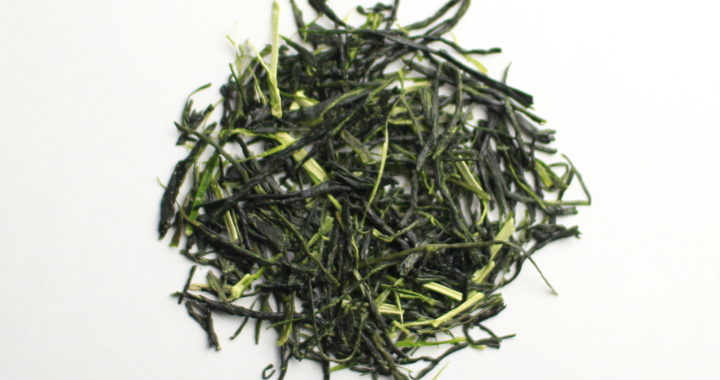If you search how to assess tea quality, one of the criteria you will find is a uniform, deep green colour and a consistent leaf size. However, are this criteria inclusive enough to appreciate the wonderful thing that is Aracha?
What is it?
Also called “farmer’s tea”, “raw tea”, or just unrefined tea, Aracha is the result of the first tea processing stage: steaming, rolling and drying. Processing is usually carried out by farmers themselves, or in shared local factories. Aracha encompasses all the parts of the leaf, including the stems, veins, baby hairs and bits of broken down leaf. Special teas, such as tencha (the precursor to matcha), are an exception. Since the leaves need to be finely ground, the coarse stems and veins need to be removed. However, this post will mainly refer to sencha.
Aracha is ready to drink as-is and it’s what you’ll receive if you buy tea directly from farmers. However, in Japan a lot of tea is sold through auctions to big wholesalers. Larger companies buy tea in bulk then put it through a second processing, which entails sorting, cutting and blending. The result is called refined tea.
Sorting: creates uniformity of colour and size. Colour sorting machines detect the lighter green colour of stems and filter them out. Then, the tea is sieved several times to remove small particles, and separates tea according to leaf size.
Cutting: the leaves may be cut so that they all have the same size. This is typical of lower grade teas.
Blending: wholesalers may then blend the teas of different farmers or harvest seasons to achieve a more consistent, standardised taste, which is optimal for selling large quantities.
Effect on the taste
Now, what does this all mean in terms of the actual taste of the brew? The answer isn’t black or white, and secondary processing might suite certain types of tea, especially lower quality ones. However, for other teas, it might ruin their personality.
You might think, “why wouldn’t I want my teas sorted?” since sorting entails less dust and guarantees all of the leaves will steep at a similar pace and intensity, so the resulting brew will be balanced and nice. That is a valid point, especially since you don’t want the sweet, slowly-unfolding aroma of long leaves to be spoiled by dust that becomes bitter very quickly. However, this is where the farmer’s skill makes all the difference.
When tea is processed with care and patience, it will result in one whole leaf twisted into one long needle. The higher the amount of whole, unbroken leaves, the better the processing technique. Of course, some dust is inevitable, but when the processing is good, the amount of dust will be under 20%. When it is in between 10-15%, dust can actually be beneficial, since it gives colour and body to the brew, without affecting the taste too much. Moreover, during processing the bud often breaks into smaller pieces. It can easily be mistaken for dust but, it is in fact a precious component packed with flavour. If you don’t sift the dust, you keep small bud pieces and the soft baby hairs of the bud and leaf. The presence of baby hairs in tea means that young sprouts were harvested and indicates the tea’s quality.
Therefore, even if it seems logical to sort tea, there is a case to be made that sorting is not necessary when it comes to high grade Senchas. For starters, there are many subtle tastes that you can lose when sorting tea. The stems of the leaves of Aracha are sweeter and store less bitter components. Arguably “kukis” give more body to the tea (see experiment by Hojo tea http://hojotea.com/en/posts-46/). When I drink kukicha, it has an entirely different set of fresh flavours and when, present in sencha, it adds to the complexity of the tea.
Basically, aracha tea beautifully encompasses the specificity of the season, harvest, particular year, region and farmer. This variation is something to be appreciated and explored.
Why is tea refined?
So why is secondary processing still popular in Japan?
On one hand, it makes economic sense. In order to sell the tea as one product, even if it comes from many different farmers in different regions of Japan, it has to be standardised. Sorting, cutting and blending creates uniformity. On the other hand, some teas might benefit from standardisation.
However, there are some aspects of secondary processing which still baffle me, respectively: what’s the problem with the stems? It seems so arbitrary, but the Japanese tea industry (especially government regulators) decided the lighter green strands are not aesthetic. In Japan, one of the biggest honours to a farmer is to produce Competition Grade Tea, accredited by the Ministry of Agriculture, Forestry and Fisheries. In order to produce such high quality tea, a farmer usually needs over a decade of experience to perfect their crop. However, one of the criteria for a winning tea is a uniform deep green colour. It is a very strict, traditional competition, and even if a tea is delicious- maybe more delicious than a winner tea- if it performs poorly on one of these categories (for example, uniformity of colour) it doesn’t have a chance to win.
Whether aracha or refined tea is better is much disputed, and not enough scientific research has been produced regarding the chemical composition of the brew. So what we are left with is personal taste. Today, with the rise of online sales platforms, it is much easier to buy tea directly from the farmer, instead of having to go through big wholesalers. The best way to judge whether you prefer aracha or not, is to try and compare as much as you can. So go ahead and get some!
by Alexandra Lulache


Thanks for this post! I adore Aracha, and drink it every morning.